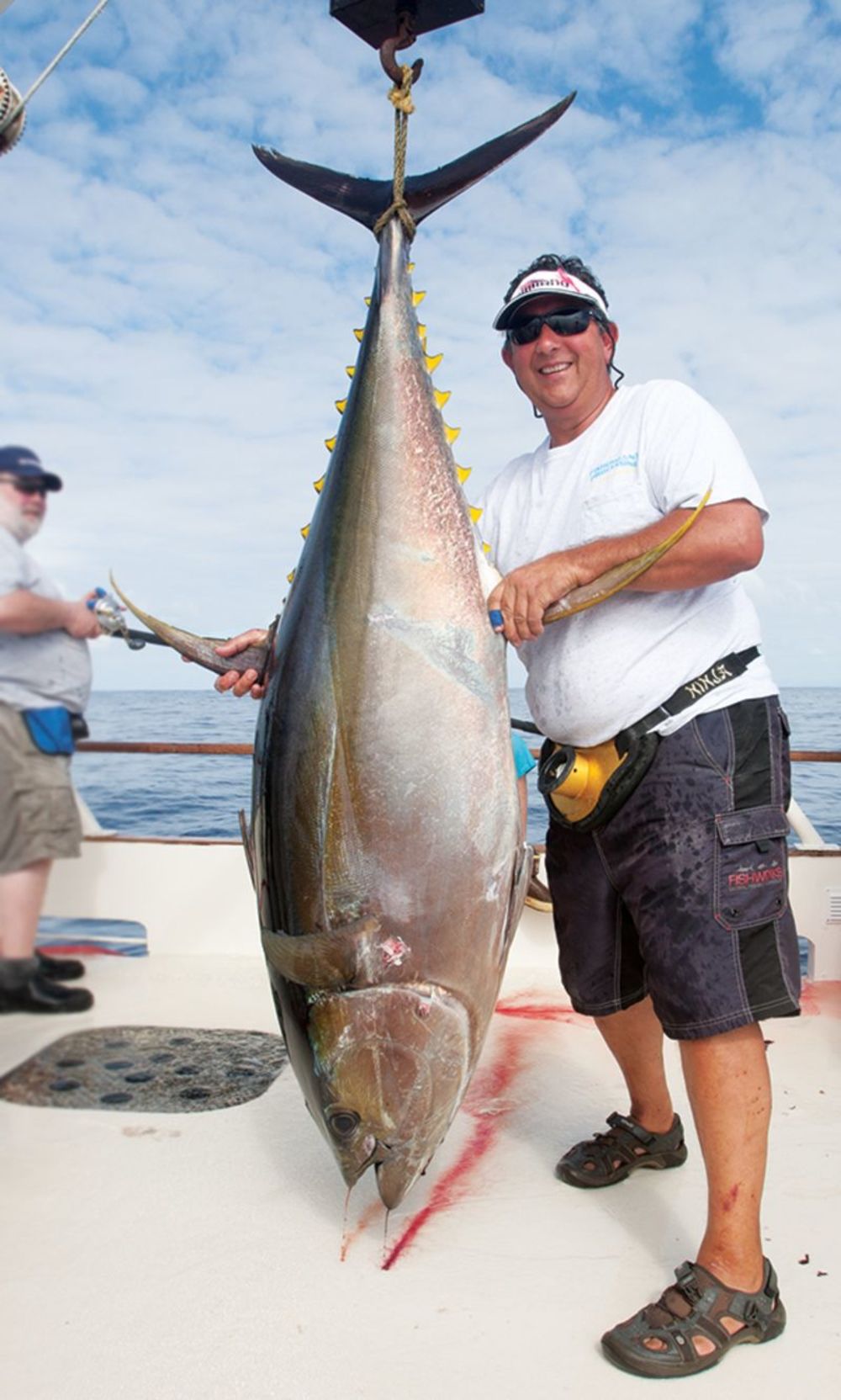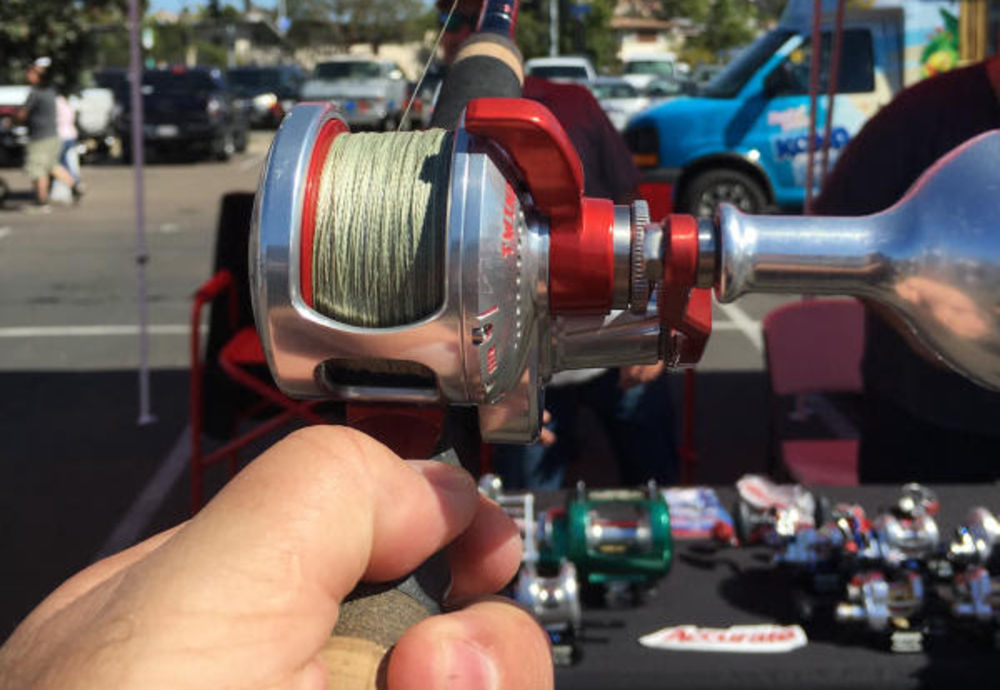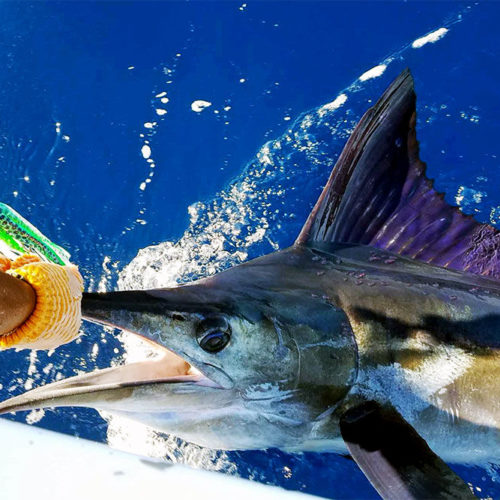
How to stack braided line of different pound tests on light reels for big gamefish.

Big tunas require plenty of line capacity, or brute strength and high drags to turn their head.
With the introduction of braided fishing line by Russ Izor in the 1980s, big-game fishing as we know it changed drastically. With the diameter of the braided line being reduced significantly, many anglers started to realize the larger reels of yesteryear could either hold a ton of braid, or they could start looking for alternative reels to fish. Once braid was accepted by a few peer group leaders, its popularity with the west coast anglers surged, sparking reel manufacturers to design smaller reels that would put out more drag and handle more pressure internally.
The revolution was started with new, smaller reels being designed for cranking power and drag, plus rods that had a more forgiving action for the non-stretch in braided line, to effectively fight fish of considerable size. The idea of “small reels, big fish” gained traction. Guys are now using reels a little bigger than your fist and landing fish over 100 pounds regularly. With the adoption of lever drags on these reels, the angler knows exactly where his drag setting is during the battle.
As anglers became more familiar with braid and its properties, new knots were developed and people took time to experiment with setting up line on their reels. On the West Coast, there is a group of anglers we refer to as "long rangers" that travel down to the islands and banks outside Cabo San Lucas and mainland Mexico for up to 21 days at a time. These anglers are fishing from dead boats for trophy yellowfin tuna up to 400 pounds. For them, line capacity on a reel is critical. A group of these anglers came up with the idea of stacking braid and perfected the connections to increase their catch rate percentages.
The reasons to stack braid on smaller reels is to gain maximum line capacity. Manufacturers designate line capacities with the assumption that only one diameter of braid will be used as the main line. When stacking braid with two different diameters, you must know the weights and strengths of the species you're targeting. There are a lot of gamefish that have enough power to spool reels, so capacity is key. When stacking braid, we put the thinner diameter on the bottom, maybe 200 yards, and the higher test on top. The rationale behind this is it's very difficult to break braid on a dead pull unless the line has been frayed. The rod will likely break before the line.
So on a 400-size reel that holds 325 yards of 50-pound braid, take 40-pound braid and put 300 yds on the bottom with another 75 to 100 yards of 65-pound braid on top. It gives the reel a little more line capacity. With the heavier line on top, anglers can actually increase drag on the fish and pull harder at the end of the battle.
Most large fish are lost coming to the boat. Anglers need enough line capacity to handle a good run, but also enough strength to tighten the drag, getting the fish within gaffing distance. This is a common practice with a lot of anglers fishing smaller tackle for bigger fish. The thought behind it is not to fight the big bulky tackle but utilize comfortable tackle that is easy to handle over the duration of the fight. There is no set combination of line sizes to stack, but lines within 20 to 30 lb differences work well. Putting the capacity line size on the bottom (smaller diameter) and the heavier on top seems to be what most anglers do.
One example I have noticed the last couple years is spooling an Accurate Dauntless DX2-600N with 65-pound braid on the bottom and putting one hundred yards of 80-pound on top, finishing with a shot of fluorocarbon leader. The 65-pound will handle 20 to 25 pounds of drag, no problem. Then once the reel gets a couple wraps on the spool of 80-pound, the angler can increase the drag pressure as the fish approaches the boat . This setup is used primarily for casting surface iron or poppers to foaming fish with an 8-foot heavy rod that will go directly to the rail once the fish is settled in. Stacking braid is a specialized technique when targeting bigger gamefish, but also works when fishing bottom fish in deeper water.

Light, compact reels can catch big fish.
Stacking the braid on the reel is a fairly easy process. There are a couple ways to do it. One of the easier ways to do this is to tie a 25-turn Bimini Twist in the two different diameter lines. Connect the two lines together via cat's paw connection. I have never seen a cat's paw connection break, and the cool part of this connection is it will go through the guides the same way a solid line would.
The other way of connecting braid is by using hollow core line and splicing lines into each other. They are held together similar to a Chinese finger puzzle. The harder they are pulled the tighter they hold. This takes needles and practice. Very important here to test all your connections. Last year, I had one fail on a fish that was a real trophy.
It's up to the angler which connections they want to use when stacking braid. Become an expert in whichever connection you prefer. The only way to become good is to practice, and the perfect place is in front of the TV or kicking it in the backyard. Don’t get discouraged if your first few connections fail--you will get the hang of it. Personally, I use the double Bimini connection which works great, but it is not as clean as the splice.
There are two schools of thought when fishing braid.
One technique is to put enough drag on a reel so its more like hand to hand combat, which allows the rod wear the fish out, with the main objective of getting its head coming up. This way you continue to put pressure on the fish without letting him get his head down before bringing him to gaff. More experienced anglers will do this, and line capacity is usually not a factor. They are using the power of the rod and the stopping power of the drag. You need to know what you are doing and be in some kind of shape to exert that much energy on those larger fish. The rail is extremely important too as a fulcrum.
The other way anglers tend to fish is to rely on the line capacity of the reel and fish a little lighter rod with less drag. This technique lets the fish wear itself out versus exerting all your energy trying to break its spirit. The downsides to each technique are:
1) If you are going to fish heavier drag, it wears on you, so stamina is important. Its extremely important to have all connections, knots, crimps, and splices tested first by pulling on them with some weight. It's important to make sure you stay clear of the boat and other anglers hooked up. Deckhands will be there to assist, or on a private boat, someone will drive you away from the fish.
2) Trying to play out the fish with lighter drag, with more line out, means the fish is on longer. With big fish on the line, time is not your friend. Always use the maximum-test leader that will still get bit. It's a nightmare when a good fish wears through the leader. The other possible scenario with playing out a fish is they are harder to control and you can end up with tangles.

